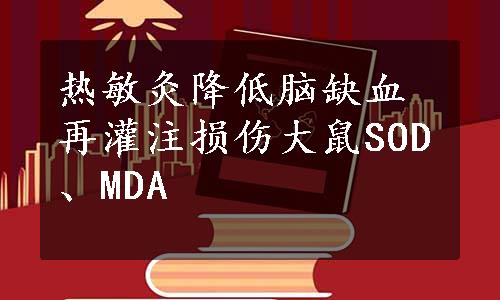
[摘要]目的 观察热敏灸对局灶性脑缺血再灌注损伤模型大鼠超氧化物歧化酶(SOD)活性、表达和丙二醛(MDA)含量的影响,以阐明热敏灸减轻脑缺血再灌注损伤的作用机制。方法 雄性SD大鼠36只,分为假手术组、模型组、艾灸组和热敏灸组。采用线栓法闭塞大脑中动脉2 h后进行再灌注,制备局灶性脑缺血再灌注损伤模型;比色法测定SOD活性和MDA含量;Western blot技术检测大鼠大脑皮质SOD2蛋白的表达。结果
热敏灸组大鼠血清和大脑皮质SOD活性[22.78±1.31(U/mL)、4 909.6±1 345.6(U/g)]均高于模型组的[20.17±1.12(U/mL)、2 602.0±1 515.5(U/g)],血清和大脑皮质MDA含量[3.78±2.00(μmol/L)、1 226.5±38.4(nmol/g)]均低于模型组的[16.82±6.70(μmol/L)、1 905.6±478.6(nmol/g)];大脑皮质 SOD2蛋白表达量(0.974±0.166)高于模型组的(0.702±0.040)。结论热敏灸具有减轻大鼠脑缺血再灌注损伤,提高SOD活性和表达、降低氧自由基含量可能是其作用机制之一。
[关键词]脑缺血再灌注损伤;超氧化物歧化酶;丙二醛;艾灸;大鼠;热敏灸
Effect of heat-sensitive moxibustion on SOD and MDA in a rat model of focal cerebral ischemia-reperfusion injury(www.xing528.com)
[Abstract]Objective The study was to observe the effect of heat-sensitive moxibustion on activity and expression of superoxide dismutase(SOD)and the content of malondialdehyde(MDA)in focal cerebral ischemia-reperfusion injury model rats.Methods Thirty-six male SD rats were randomly divided into four groups,a sham-operated group(n=6),an ischemia-reperfusion(I/R)injury group(n=10),an I/R injury with 15-minute moxibustion group(n=10),and an I/R injury with 35-minute moxibustion group(n=10).Focal cerebral ischemia-reperfusion model was induced for 2h by middle cerebral artery occlusion(MCAO)followed by reperfusion.SOD activity and MDA content were determined by colorimetry,andthe cortical expression of SOD2 protein was detected by western blot technique.Results SOD activities in serum and cortex[22.78 ±1.31(U/mL)、4 909.6 ±1 345.6(U/g)]in the rat of heat-sensitive moxibustion group were improved compared with model group[20.17 ±1.12(U/mL)、2 602.0 ±1 515.5(U/g)],MDA contents[3.78 ±2.00(μmol/L)、1 226.5 ±38.4(nmol/g)]were decreased compared with model group[16.82 ±6.70(μmol/L)、1 905.6±478.6(nmol/g)],and the cortical expression of SOD2 protein(0.974±0.166)was higher than that(0.702±0.040)of model group.Conclusion Heat-sensitive moxibustion could reduce the damage from cerebral inchemia-reperfusion,which might be through improving SOD activity,increasing SOD expression and decreasing MDA content.
[Key words]brain ischemia-reperfusion injury; superoxide dismutase; malondialdehyde;moxibustion; rats; heat-sensitive moxibustion
脑血管疾病是危害人类生命和健康的主要疾病之一,缺血性脑血管病约占全部脑血管病的80%左右[1]。因此脑缺血后再灌注是大多数缺血性脑血管病的主要病理生理过程。多数情况下,缺血后再灌注可使组织、器官功能得到恢复,损伤的结构得到修复,但有时缺血后再灌注,反而加重组织、器官的功能障碍和结构损伤,即引起脑缺血再灌注损伤。研究发现,脑组织缺血2 h后进行再灌注可造成脑缺血再灌注损伤[2]。然而脑缺血再灌注损伤的发生机制尚未完全阐明,目前认为自由基的作用是脑缺血再灌注损伤的重要发病环节,因为生成的自由基可与各种细胞成分,如膜磷脂、蛋白质、核酸等发生氧化反应,造成细胞结构损伤和功能代谢障碍[3-4]。临床实践表明,热敏灸治疗急性缺血性中风具有较好的效果[5];而且动物研究也观察到,热敏态“大椎”穴能显著缩小大脑中动脉缺血再灌注损伤模型大鼠的脑梗死面积,即减轻脑缺血再灌注损伤[6-7]。然而热敏灸是否通过增加抗氧化酶表达、提高抗氧化酶活性和降低自由基作用,达到减轻脑缺血再灌注损伤的作用机制还不十分清楚。本研究旨在阐明热敏灸减轻脑缺血再灌注损伤的作用机制,以促进热敏灸在临床缺血性中风防治中的应用。
免责声明:以上内容源自网络,版权归原作者所有,如有侵犯您的原创版权请告知,我们将尽快删除相关内容。




